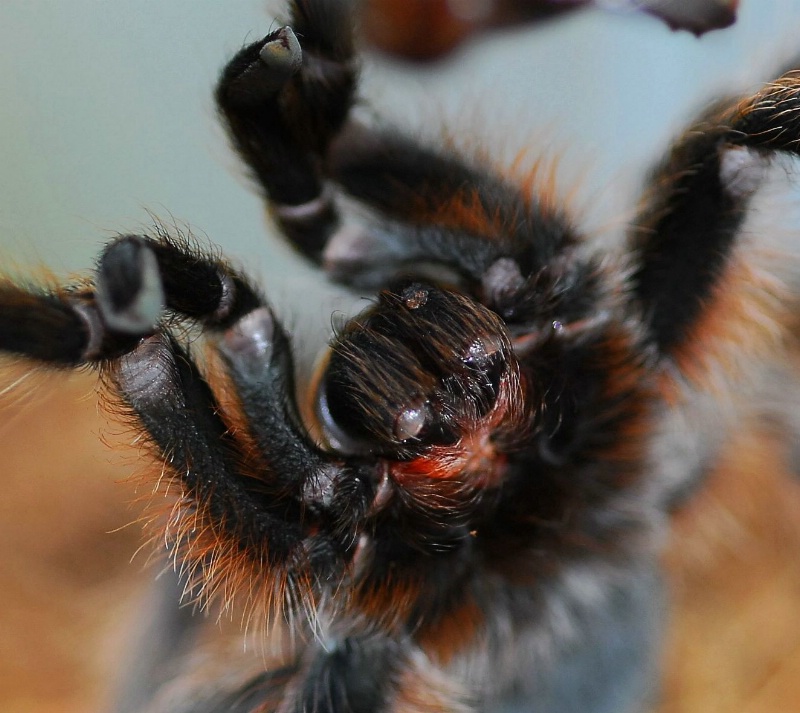" Tex "

Uploaded: August 02, 2009
A wild immature male Texas Brown tarantula (Aphonopelma hentzi) showing pedipalps with cymbia, chelicerae and fangs. The Texas Brown is one of the most docile species of tarantula. Although being irritated he still is not exposing his fangs like they do in the attack mode.
Copperas Cove, Texas
2 August 2009
Exif: F Number: 4, Exposure Bias Value: 0.67, ExposureTime: 10/600 seconds, Flash: Strobe return light not detected., ISO: 400, White balance: Auto white balance, FocalLength: 105.00 mm, Model: NIKON D200
Jim Baines
 August 02, 2009
August 02, 2009
Think of the pedipalps as hands.
Chelicerae are pointed appendages which are used to grasp food, and are found in place of the chewing mandibles most other arthropods have. Additionally, some chelicerae, such as those found in spiders, are hollow and contain (or are connected to) venom glands, and are used to inject venom into prey or a (perceived) threat. Except for a few small families of spiders, all spiders have venom that is injected into their prey through openings in the tips of their fangs when a spider bites something. The glands that produce this venom are located in the two segments of the chelicerae, and, in most spiders, extend beyond the chelicerae and into the cephalothorax.
Think of the chelicerae as being jaws that tear and crush prey.
The fang, the organic functional equivalent to a hypodermic needle is what penetrates the skin, fur, or exoskeleton of the spider's target--spider mouthparts are primarily intended for envenoming a spider's prey in most species, typically insects and other small arthropods; not for biting humans. The basal portion includes all or part of the spider's venom glands, which can be squeezed under voluntary control by the spider to force venom out of the glands and into the wound.[1] When a spider bites, the two parts of the chelicerae come together like a folding knife, and when making a threat display or actually preparing to bite, the spider will open the angle of the fangs with the basal portion of chelicerae and also open the angle of the basal portion with the cephalothorax. In the tarantulas and other and other Mygalomorphae, the horizontal separation of the tips of the fangs does not change much, but in the other spiders the tips of the fangs move apart from each other as well as elevating. Even the tips of the fangs of the rather large spider shown above are quite sharp, and the spider's body is well adapted to driving the fangs into flesh. Some spider bites, such as those of the Sydney funnel-web spider, are reported to have penetrated toe nails and soft leather shoes.
Think of the fangs as something that could make you curse violently.
#1162588
Dominick M. Dimacale
 August 02, 2009
August 02, 2009
Dominick #7807146
Jack Gaskin August 02, 2009
Wonderful Shot!!!Happy Shooting
Jack #7807366
Tammy Espino August 02, 2009
EEEEEEEEEEK, glad I never come upon them or scorpions or rattlesnakes when I am wandering around in the desert..You can keep them!!Michelle Alton August 03, 2009
This photo and description certainly provide everything we ever wanted to know about tarantulas. What a wonderful new pet you have! And this macro is outstanding. #7809736Jane E. Kirn August 03, 2009
Wonderful macro Jim!!!!!! Great critter. Super POV. #7813553Sign up for an interactive online photography course to get critiques on your photos.
Discussions by Category: You can view photo discussions on various themes in the Community > Photo Discussions section of the site.
BetterPhoto Websites: If you see an orange website link directly under the photographer's name, it's totally okay. It's not spam. The reason: BetterPhoto is the one that offers these personal photography websites. We are supporting our clients with those links.
Unavailable EXIF: If there is no other information but 'Unavailable' in the EXIF (meaning no EXIF data exists with the photo), the 'Unavailable' blurb is not displayed. If there is any info, it shows. Many photos have the EXIF stripped out when people modify the image and resave it, before uploading.
The following truth is one of the core philosophies of BetterPhoto:
I hear, I forget.
I see, I remember.
I do, I understand.
You learn by doing. Take your next online photography class.
Copyright for this photo belongs solely to Jim Baines.
Images may not be copied, downloaded, or used in any way without the expressed, written permission of the photographer.
Contact photographer via gallery
Log in to follow or message this photographer or report this photo.

I already have an account!

